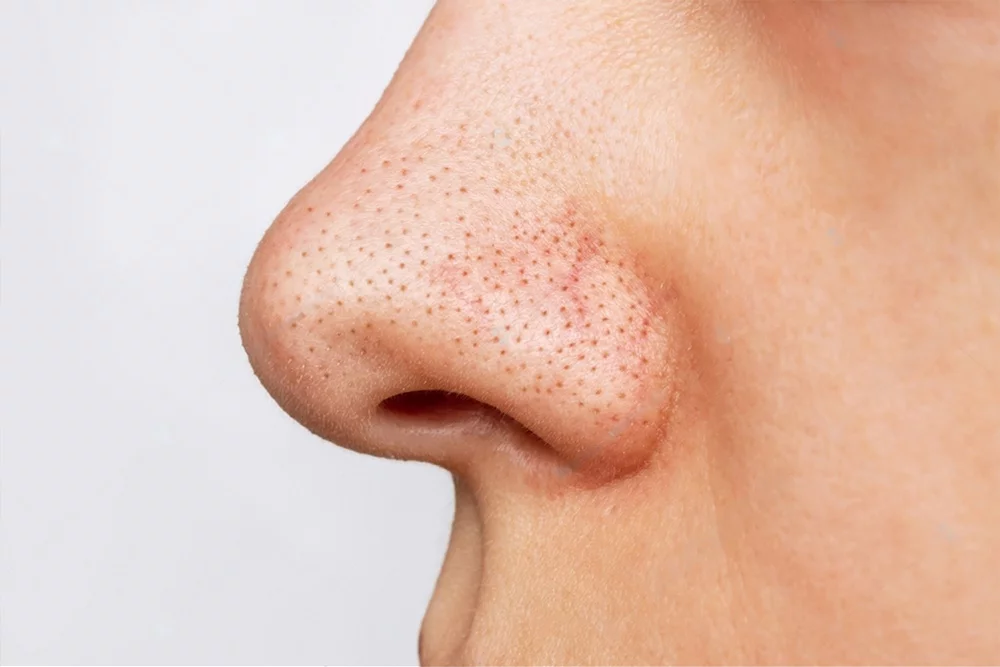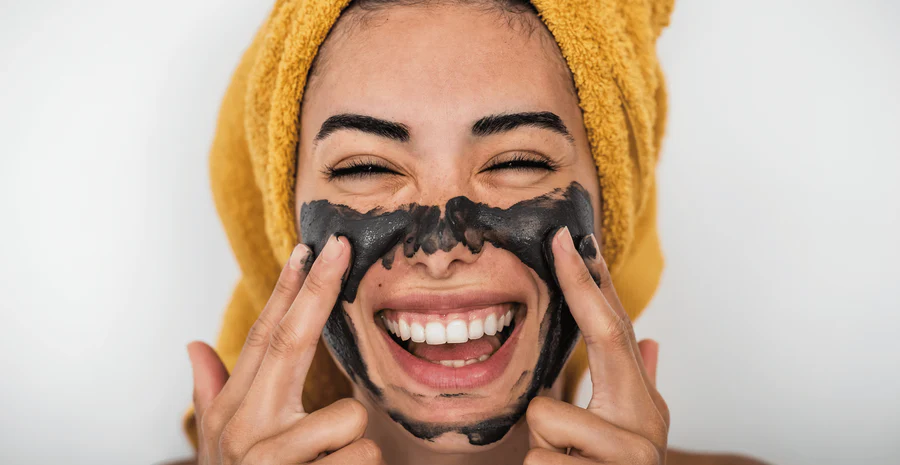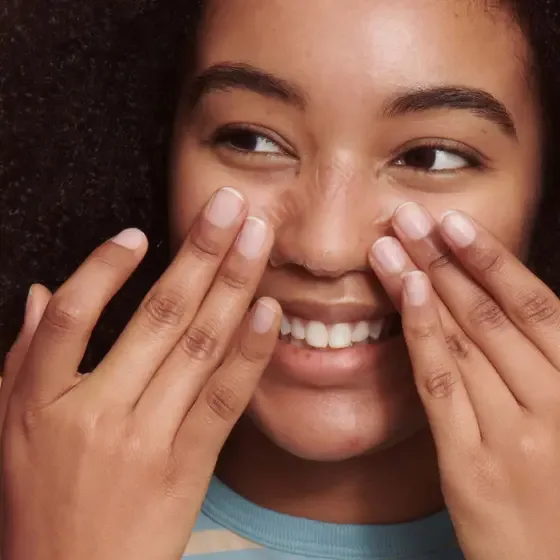Dealing with blackheads can be a frustrating experience for many people. These small, dark spots, called “open comedones,” are a form of acne that clogs our pores and tends to appear on the face and other areas with high concentrations of oil glands. They are identifiable by the small, dark, or black-colored bumps they create on the skin’s surface. The good news is that you can successfully deal with blackheads at home if you take the right approach. This comprehensive guide will provide various methods and tips to help you achieve smoother, clearer skin.
Table of contents
What Are Blackheads?
To effectively treat blackheads, it’s essential to understand what they are and how they form. These small blemishes, also known as open comedones, develop when hair follicles become clogged with a combination of oil (sebum), dead skin cells, and sometimes bacteria. Unlike whiteheads, which remain closed and appear white or flesh-colored, this type of acne stays open at the skin’s surface. Exposure to air causes oxidation, resulting in the characteristic dark appearance.
Blackheads can appear on different body parts but are usually found on the face, especially on the nose, forehead, and chin. They tend to be more prevalent in people with oily skin, as the surplus oil production can lead to pore blockages. Nevertheless, people with other skin types may also encounter blackheads.

The main factors that cause blackheads
- Excess Sebum (Oil) Production
- Hormonal Changes
- Genetics
- Cosmetics and Skincare Products
- Diet and Lifestyle Factors
- Sweat and Humidity
- Bacterial Activity
- Accumulation of Dead Skin Cells
Effective Ways to Get Rid of Blackheads at Home
Regular Cleansing
- Gentle Cleansing: To remove blackheads, it is important to establish a regular and gentle cleansing routine. Wash your face twice daily using a mild, non-comedogenic cleanser to eliminate dirt, excess oil, and makeup. By doing so, you can maintain clean skin and prevent the formation of additional blackheads.
- Exfoliation: For clearer skin, exfoliate 2-3 times a week with a gentle product containing salicylic or glycolic acid to remove dead skin cells and prevent blackheads.
Steam and Extraction
- Steam Your Face: Steam your face for 5-10 minutes before attempting to remove blackheads. This opens up your pores, making it easier to extract them.
- Use an Extractor Tool: You can invest in a comedone extractor tool, a metal tool with a loop at one end designed for safe blackhead removal. Gently press the loop around the blackhead to extract it.

DIY Blackhead Strips
1. Egg White and Tissue Paper Blackhead Strip
- Separate the egg white from the yolk and place it in a small bowl.
- Cleanse your face to remove dirt and excess oil.
- Apply a thin layer of egg white to areas prone to blackheads using a makeup brush.
- Place a thin facial tissue or toilet paper over the egg white and gently press it down.
- Let it dry for 15-20 minutes until it feels tight.
- Peel off the tissue carefully, lifting away blackheads and impurities.
- Rinse with lukewarm water to remove any residue.
2. Honey and Cinnamon Blackhead Strip:
- Mix one tablespoon of honey with one teaspoon of cinnamon powder to create a thick paste.
- Cleanse your face to remove dirt and oil.
- Apply the mixture to areas with blackheads and leave it for 15-20 minutes.
- Once dried, gently peel it off, extracting impurities.
- Rinse thoroughly with lukewarm water.
3. Gelatin and Milk Blackhead Strip:
- Combine one tablespoon of unflavored gelatin with 1-2 tablespoons of milk to create a smooth paste.
- Heat the mixture in a microwave for 10-15 seconds until warm (but not too hot).
- Use a makeup brush to apply a thin layer to blackhead-prone areas.
- Allow it to dry for 15-20 minutes.
- Gently peel off the dried mask.
- Rinse with lukewarm water to remove any residue.
These DIY blackhead strips can be an effective and cost-efficient way to remove blackheads at home. However, always patch-test any new mixture on a small area of your skin to ensure you don’t have an adverse reaction, and use them in moderation to avoid over-drying your skin. If you have sensitive skin or are prone to skin allergies, it’s best to consult a dermatologist before trying any DIY treatments.

Masks and Natural Remedies to Getting Rid of Blackheads
- Clay Masks: Apply a clay mask once a week. Clay helps absorb excess oil and tighten pores, reducing the appearance of blackheads.
- Oatmeal and Yogurt Mask: Mix oatmeal and yogurt to form a paste and apply it to your face. Leave it on for 15-20 minutes before rinsing. Oatmeal acts as a gentle exfoliant.
- Honey and Cinnamon Mask: Mix honey and cinnamon powder to form a paste. Apply it to your face for 15-20 minutes before rinsing. Honey has antibacterial properties, while cinnamon can exfoliate and improve blood circulation.
- Baking Soda Scrub: Create a paste by mixing baking soda with water and gently massage it onto your face in circular motions. Rinse thoroughly. Baking soda acts as a mild abrasive and helps exfoliate the skin.
- Apple Cider Vinegar Toner: Dilute apple cider vinegar with water (1:3 ratio) and apply it as a toner. It can help balance the skin’s pH and reduce the appearance of blackheads.
Maintenance
Adopting a well-balanced diet and staying hydrated contribute to overall skin health. A nutrient-rich diet with fruits, vegetables, and antioxidants can support clearer skin. Additionally, using a lightweight, non-comedogenic moisturizer helps maintain skin hydration without clogging pores.
Hands Off
Resisting the temptation to squeeze or pick at blackheads is crucial. This habit can lead to inflammation, infection, and scarring. Instead, opt for gentle extraction methods or professional treatments when necessary.
Consult a Dermatologist
If blackheads persist despite your efforts, consulting a dermatologist is advisable. Professional treatments, such as chemical peels, microdermabrasion, or prescription medications, may be recommended based on your skin type and condition.
Some frequently asked questions (FAQs) about blackheads
Where do blackheads typically appear?
- Blackheads are most commonly found on the face, especially in the T-zone (forehead, nose, and chin). However, they can also appear on the back, chest, neck, and shoulders.
Can squeezing or picking at blackheads make them worse?
- Yes, squeezing or picking at blackheads can make them worse. It can lead to skin irritation, inflammation, and potential scarring. It’s generally best to avoid this behavior and instead use proper skincare and extraction methods.
How can I prevent blackheads?
- To prevent blackheads, maintain a consistent skincare routine that includes cleansing, exfoliation, and the use of non-comedogenic (non-pore-clogging) products. Avoid excessive touching of your face, and consider dietary and lifestyle factors that may contribute to acne.
What is the best way to remove blackheads at home?
- You can remove blackheads at home through methods such as using DIY blackhead strips, steaming your face before gentle extraction, applying clay masks, or using exfoliating products with ingredients like salicylic acid or glycolic acid. However, be gentle and avoid squeezing or picking, which can lead to skin damage and infection.
How often should I exfoliate to prevent blackheads?
- Exfoliation should be done 2-3 times a week with a gentle exfoliating product containing ingredients like salicylic acid or glycolic acid. Over-exfoliating can irritate the skin and worsen the condition.
When should I see a dermatologist about my blackheads?
- If you’ve tried various home remedies and over-the-counter products without success, or if your blackheads are accompanied by severe acne, it’s advisable to consult a dermatologist. They can provide professional guidance and may recommend prescription treatments if necessary.
Are there any professional treatments for blackheads?
- Yes, dermatologists can offer professional treatments for blackheads, such as chemical peels, microdermabrasion, and extraction procedures. They may also prescribe topical or oral medications to manage more severe cases of blackheads and acne.
In conclusion, it is possible to treat blackheads at home if you follow the right approach. This includes keeping a regular skincare routine, trying natural remedies, and maintaining a healthy lifestyle for clearer and smoother skin. However, if your blackheads persist or get worse, it is best to consult a dermatologist for personalized treatment options. You can successfully eliminate blackheads and achieve a more radiant complexion with patience and consistency.
Also Read:
Rejuvenate Your Skin with 5 DIY Aloe Vera Masks



